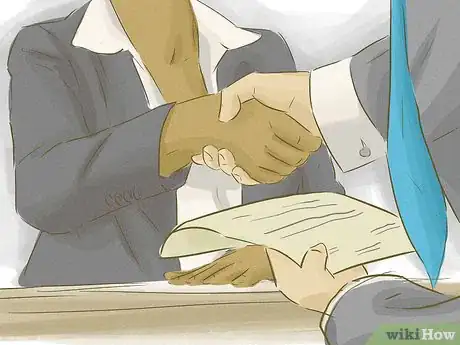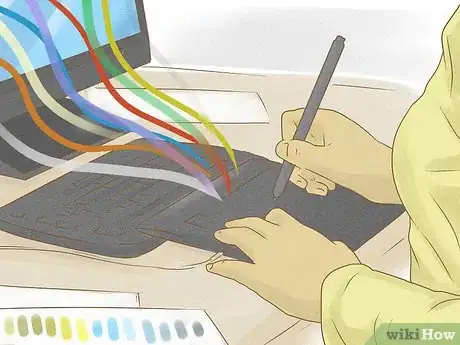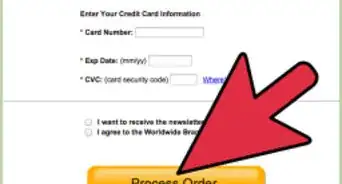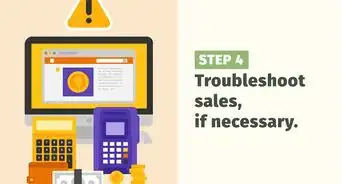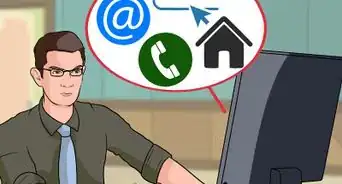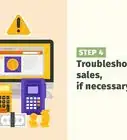This article was co-authored by Art Lewin. Art Lewin is an Entrepreneur based in Los Angeles, California. He specializes in business, sales, marketing, and real estate investing. Art is the CEO and Founder of four companies based in Los Angeles: Art Lewin Bespoke, Healthy Choice Labs, SFR Properties, and Professional Business Network (PBN). Art is known globally for his exclusive custom-made and ready-to-wear business wear designs. Some of his notable clients include royal family members, politicians, and Hollywood stars including Hugh Hefner, Sylvester Stallone, Johnny Carson, Steve Allen, and William Shatner.
wikiHow marks an article as reader-approved once it receives enough positive feedback. In this case, 100% of readers who voted found the article helpful, earning it our reader-approved status.
This article has been viewed 327,403 times.
Getting into product distribution means entering a big industry. For example, there are roughly 300,000 distributors in the United States that produce a combined $3.2 trillion in annual revenue. Despite this large number of participants, the fragmented and competitive nature of the industry allows for plenty of profitable new entrants.[1] With some planning and entrepreneurial spirit, you too can be on your way to owning a successful distribution business.
Steps
Creating a Business Strategy
-
1Decide what type of distribution business you will run. Distributors can be split into two categories based upon who they serve. First, retail distributors buy from wholesalers or manufacturers and sell products directly to consumers (end-users). In contrast, wholesale merchant distributors buy from manufacturers and resell the products to retailers or other distributors. Which one is right for your business will depend on your goals and experience.
-
2Decide what you would like to distribute. You could focus on a specific product or offer a variety of items. Your decision could be based on a passion or on a product that is hard to find in your own personal experience.
- While many large companies are served by equally large distributors, these distributors are unwilling or unable to serve smaller, more specialized business. A good idea, especially in a crowded market like beverage distribution, might be to provide niche products to these specialized retailers.[2]
Advertisement -
3Put together a business plan that lays out the full vision of your new distribution business. A business plan allows you to follow a direction for making your business a success. This plan will included the type of distributor you will be, the products you plan to offer (at least initially), the name of your company, your target customer base, shipping method, and a general strategy. This strategy can be as simple as focusing on fast and effective service, or more complicated, such as specifying a way to offer specialized products that are unavailable from other distributors.[3]
- Writing a business plan can be the most complicated part of starting a small business. For more information, see how to write a business plan for a small business.
-
4Estimate your startup costs. In addition to a business plan, you will also need some idea of how much money it will take to get your business up and running. As a distributor, your single biggest expense will be inventory. This means that your startup costs will vary widely depending on what you are planning on selling. You will also need a place of business, office equipment, and some warehouse equipment (like forklifts if you have heavy products or shelves if you have lighter products).[4]
- For an example of how much costs can vary, two successful business in different markets started with $700 and $1.5 million, respectively. The first, a tie company, started with such a small amount because the business was run from home, started with low inventory costs, and didn't require any equipment to manage. The second, a fine wine retailer, had expensive product to buy, had to rent a large warehouse, and had high operating expenses like temperature-controlling the warehouse and investing in equipment to transport the product around the warehouse and to customers.[5]
- The advent of online distribution has also created new options for distribution businesses. One of these, drop-shipping, allows for distributors to avoid all inventory control and shipping issues by never taking physical possession of the product. Never taking control of inventory means that your initial investment can be much lower. However, this a crowded market that can be difficult to make money in. See how to start a drop shipping business for more information.
-
5Figure out how to sell your products. This will depend largely on who your customers are and what type of products you're selling. In any case, your goal should be to let potential customers know about your business and what you can offer. This can mean anything from advertising to personal meetings with store owners to search-engine optimization (SEO).[6]
- As part of selling, put together a marketing plan so that you can promote your services. This may include the costs of printing brochures, creating catalogues detailing your offerings, and placing ads in trade journals or magazines. As a small business, you can expect to do a lot of marketing for the first few years until you have a good-sized customer base and have established a reputation. See how to create a marketing plan for more information.
-
6Determine how you will be funding your business. With low startup costs, you may be able to purchase your inventory and get your business started with money you already have. However, more expensive startup costs may require you to take out a loan. See how to get a small business loan for more information.[7]
Getting Your Business Started
-
1Form your company legally. If you're planning to operate as a corporation, LLC, or any other type of company, you'll have to legally create the company before you can do business. Check with your state regulations and see if you need to create an operating agreement or another type of founding document. Gather any business partners you have for this venture and have them sign any legal documents you fill out.
- The primary advantage of forming a company is that your finances will be legally separated from those of your company. This minimizes risk to you in the event that your business is sued or goes into bankruptcy.
-
2Make your business official by getting it licensed and registered. You will have to register your "doing business as" (company) name with your city or county business office. Other legal steps may be required to get your business started. Contact your local Small Business Administration office for more information.
-
3Find a location for your business. The size of the space you need to hold your inventory will be determined by the size of your product and your delivery method (you don't need inventory space for drop-shipping). You should consider starting off small as your business builds a reputation. As your business grows, you can move into larger facilities that can accommodate your inventory needs, such as a distribution warehouse.[8]
- It is conceivable that a successful distribution business could be built and run from your home. This depends on the physical size of your inventory, however.
-
4Contact manufacturers or wholesalers of your products. You will need to find sources from which you will buy your product. To locate manufacturers and wholesalers, contact the National Association of Wholesaler-Distributors or use an online resource like http://thomasnet.com.
-
5Purchase inventory. Once you've found a source for product, it's time to place your first order. Unless you're using the drop-shipping model, you'll need to purchase however much inventory you think you can sell. Keep in mind not only your budget and space constraints but also how many items you will likely sell at first. This is especially true of products with a short shelf-life. When ordering inventory, keep the following tips in mind:
- Don't buy too much inventory, especially at first.
- Try to estimate your customer's needs before you invest in inventory.
- If you can get away with low overhead (storing items at home or at a cheap location) at first, go for it.
- Purchase inventory to a point where you can sell that inventory before you have to pay the manufacturer or distributor for it.[9]
-
6Create a website for your business. In addition to simple contact information, this website should describe prices and product offerings. This is especially important if you sell directly to consumers.
- You can also invest in search engine optimization (SEO) that directs potential customers directly to your website by placing it higher in search engine results. See how to improve search engine optimization for more information.
-
7Design a catalog that lays out your products. You can send these out to potential clients so that they can see what you have to offer. Another option is to highlight a few items, and then lead your potential clients to a website that shows off your full inventory.
-
8Market your product to potential customers. Send out your catalog to potential customers in your area. You can also make cold calls or place ads in trade publication relevant to your products. With some luck and salesmanship, your first orders will be coming in soon!
Community Q&A
-
QuestionWhat is paid up capital and what is working capital?
 Wale AdamsCommunity AnswerPaid up capital is simply the amount of money a business received from its shareholders as investments. Working capital is the difference between current liabilities and current assets.
Wale AdamsCommunity AnswerPaid up capital is simply the amount of money a business received from its shareholders as investments. Working capital is the difference between current liabilities and current assets. -
QuestionHow many items should be offered in the first catalog?
 Community AnswerIt depends on the customers' demand. Don't try to purchase unnecessary inventory.
Community AnswerIt depends on the customers' demand. Don't try to purchase unnecessary inventory. -
QuestionWhat is the usual arrangement with suppliers or manufacturers? Does the distributor pay first, or will products be on consignment and be paid to suppliers when sold?
 Sailesh KarCommunity AnswerIf you are starting a business for the first time, usually you may have to pay upfront. This is done to ensure your seriousness regarding the business. If you have some relationship with the manufacturer already, then it's possible you may be able to pay later.
Sailesh KarCommunity AnswerIf you are starting a business for the first time, usually you may have to pay upfront. This is done to ensure your seriousness regarding the business. If you have some relationship with the manufacturer already, then it's possible you may be able to pay later.
References
- ↑ http://www.entrepreneur.com/article/190460
- ↑ http://www.entrepreneur.com/article/190460
- ↑ Art Lewin. Entrepreneur. Expert Interview. 11 June 2021.
- ↑ Art Lewin. Entrepreneur. Expert Interview. 11 June 2021.
- ↑ http://www.entrepreneur.com/article/190460
- ↑ Art Lewin. Entrepreneur. Expert Interview. 11 June 2021.
- ↑ Art Lewin. Entrepreneur. Expert Interview. 11 June 2021.
- ↑ Art Lewin. Entrepreneur. Expert Interview. 11 June 2021.
- ↑ http://www.entrepreneur.com/article/190460
About This Article
To start a distribution business, contact your local Small Business Administration to help your company get licensed and registered. Then, you'll need to find a location where you can run your business. To keep your costs low, rent the smallest location you can, or work from home if your inventory is limited. To start getting inventory, contact the National Association of Wholesaler-Distributors. Once you are ready to make sales, develop a website and catalog so that you can market and sell your products. For information about developing a business plan, keep reading!







